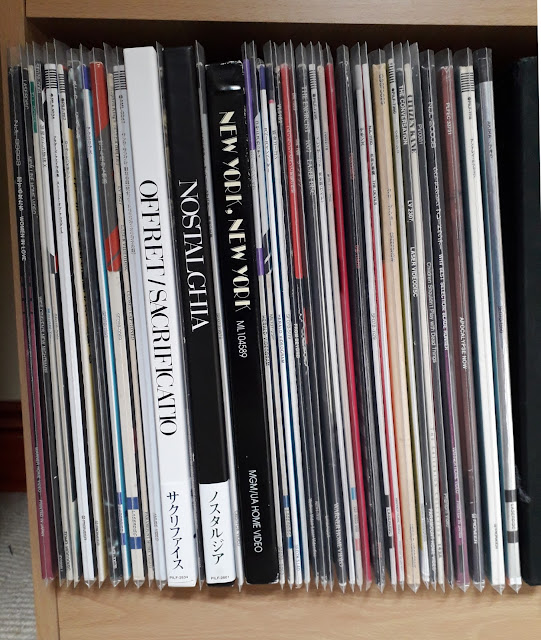Thursday, 29 April 2021
Make Room ! Make Room ! (Laserdiscs vs Blu-Rays)
Monday, 26 April 2021
Fat City (1972, dir. John Huston)
I watched Fat City last night courtesy of my old US DVD from 2002, whose tired looking transfer seemed to add to the film's grimy ambience. I'm tempted to call John Huston's film a classic of skid row poetry; it's certainly a classic, but even Tom Waits would find it hard to mine much poetry from this one, as the fate of two boxers is played out among the broken down streets, derelict lots, one-night cheap hotels and last-chance saloons of Stockton, California. I'd wager that screenwriter Robert Siegel had the film in mind when he wrote what would become Darren Aronofsky's 2008 film The Wrestler and perhaps Steve Buscemi's took some inspiration from Huston's film for his 1996 film Trees Lounge. Fat City is one of two late-career John Huston masterpieces, the other being 1979's Wiseblood, and the film is good enough to cash in my barebones DVD for Indicator's 2017 Blu-Ray which comes with a bounty of fascinating supplements, including a commentary track from film historians Lem Dobbs and Nick Redman, which for once I will put aside an hour and a half to listen to. All that to come, but for now, I indulged in a spot of armchair tourism earlier courtesy of Google Earth, seeking out locations seen in the film. My copy of the usually reliable The Worldwide Guide to Movie Locations has no entry on the film, and perhaps that's not surprising: much of the area where Conrad Hall shot those bleached-white streets and dimly-lit bars no longer exists, having been torn down after the filming was completed to make way for a highway. Outside of the film, I hadn't any previous knowledge of Stockton, but passing thru parts of the city and neighborhoods on Google Earth, very little has been done to rid the region of the blight of urban decay, with poor housing planning, poverty, drugs, and neighborhoods lost to gang violence. It's no wonder Stockton is one of California's most undesirable places to live.
If the film gains immeasurably from the shooting locations, so too is the film well served by the terrific cast, a mix of well known actors - Stacy Keach, Jeff Bridges, Candy Clarke, and non-professionals who were not so removed from the film's milieu, and I was especially fond of Curtis Cokes, a former World Welterweight Champion and trainer who plays the soft-spoken Earl with a tremendous dignity, even when fending off his erratic alcoholic lady. There's a great turn too from Art Aragon, another former boxer who plays the assistant coach. Good as Stacy Keach and a young Jeff Bridges are, Susan Tyrrell runs away with the film, playing Oma, an irascible, impetuous alcoholic. It's a shame she had such a patchy film career, but among the more forgettable fare she acted in, there were noteworthy pictures like Andy Warhol's Bad, Forbidden Zone, Tales of Ordinary Madness, Flesh + Blood, and Cry-Baby, plus voice work for two of Ralph Bakshi's animations Wizards and Fire & Ice, plus narration for the Dawn of the Dead documentary Document of the Dead.
Friday, 23 April 2021
In this month's... Electronic Sound (No. 76)
Push and Mark, the editors of Electronic Sound magazine suggest reading the latest issue sitting outside with a cup of tea and that's exactly what I did earlier, with the morning sunshine bouncing off the magazine's customary expanses of white space. The lead feature in this month's issue is David Stubbs' interview with Chris Carter and Cosey Fanni Tutti as they reflect on the music they produced as Chris and Cosey. This piece works well as a sort of prequel to the Carter Tutti feature in the March 2015 issue of The Wire. It's good to be reminded of the couple's post-TG albums, 1981's Heartbeat and the follow-up Trance (1982), both retain traces of TG DNA in Chris' rhythms and Cosey's cornet playing. In some respects the music became less interesting as the 80's wore on but albums like 1985's Techno Primitiv and 1987's Exotika have their moments. Perhaps their most widely heard track, the 1983 single October (Love Song), a lovely electro-pop confection ought to have been a sure fire hit but wasn't, such are the mysterious ways songs catch fire with the record-buying public, or don't in this case, but Chris and Cosey to my mind have achieved a level of success far beyond record sales. As they explain to David Stubbs, as early as 1981, they were offered to join Grace Jones on a world tour, and there were invitations from Depeche Mode and Blancmange, all of which were turned down so they could concentrate on their music and raise their son outside the glare of the limelight. Cosey's health problems in the late 80's notwithstanding, the duo managed to weather their four decade long partnership with little turbulence - there were none of the chemical burnouts that Coil suffered or the kind of disquieting antics that supposedly went on within Psychic TV. Closing out the feature is handy little primer on Chris and Cosey's albums which are now long out of print on CD. Perhaps Mute might consider a series of re-issues at some point.









